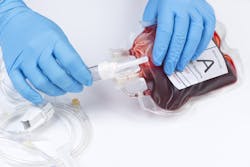Whole blood and other special considerations for pediatric massive transfusion protocols
Attendees at the session “Massive Transfusion Protocols in Pediatric Patients” learned the pros and cons of two approaches to blood transfusion in this unique setting. The details included methods for activation of protocols, acquisition of emergency-issue blood, criteria for and contents of massive transfusion protocol (MTP) packs, related laboratory testing, documentation, quality metrics, operational challenges, and the key role of communication between laboratory and clinical care teams.
Potential Benefits and Controversies of Whole Blood Use
Trisha Wong, MD, MS, associate professor of pediatric hematology and pathology at Oregon Health and Science University in Portland, introduced the topic of low-titer group O whole blood (LTOWB) with an overview of the benefits of LTOWB use in massive transfusion, requirements of accreditation organizations, and differences in the treatment concerns for pediatric patients compared to those for adult patients.
She then presented data demonstrating how few facilities are using LTOWB and how variable the practices and results of studies have been. In highlighting the current controversies over the use of LTOWB in this setting, she observed:
- Most studies are single-center studies.
- “Low titer” is variably defined.
- Age and weight limits are variable.
- Inclusion of non-trauma MTPs is variable.
- Use of leukocyte-reduction filters may decrease residual platelet count and function.
- Support of ABO-mismatched transplant procedures is still debated.
- Compatible blood for female of childbearing potential with unknown Rh type is still debated.
Traditional Approaches Can Be Improved
Amir H. Navaei, MD, assistant professor, Baylor College of Medicine, and pediatric transfusion medicine physician, Texas Children’s Hospital in Houston, presented an overview of traditional component therapy in massive transfusion. He emphasized the unique aspects of treating pediatric patients, the challenges faced at his facility and some of the initiatives used there to overcome the challenges.
He provided specific examples from his facility to explain MTP activation criteria, patient-weight-based contents of MTP packs, recommendation for initial resuscitation and goal-directed transfusion. He addressed performance indicators from the American College of Surgeons Trauma Quality Improvement program (TQIP) and shared a quality improvement dashboard of metrics, goals and percent of goals achieved for the MTPs activated throughout a span of several months.





